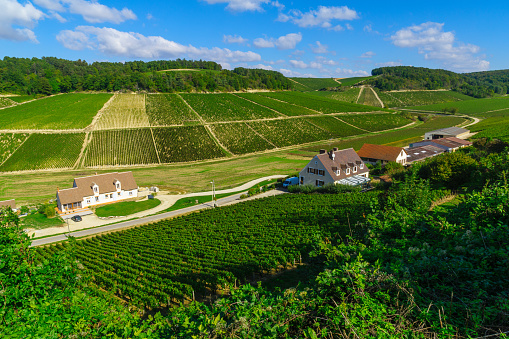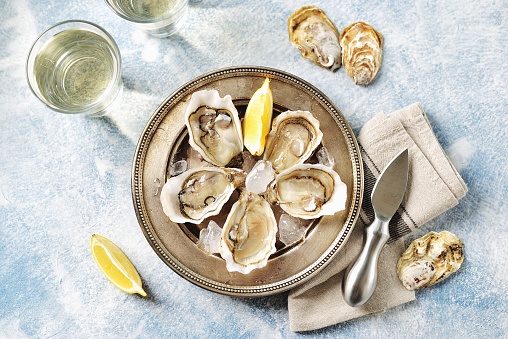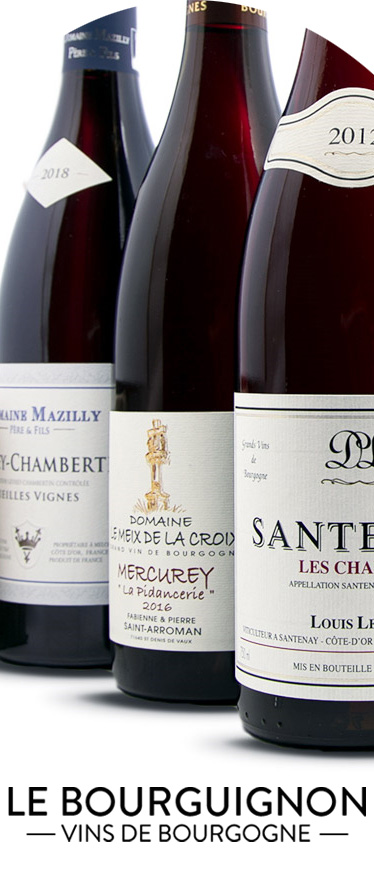Chablis wines are well known!

"Chablis today resonates, resonates very loudly. His wines have an image of great white wines from France all over the world!" according to Gérard Margeon, head sommelier
Chablis is a controlled designation of origin created in 1938. It belongs to the vineyards of Chablis in the Yonne which is located near Paris and Champagne. It covers 3,220 hectares planted in different municipalities (located about twenty kilometers from north to south and about fifteen kilometers from east to west):
-
Beines
-
Beru
-
Chablis
-
Fyé
-
Milly
-
Poinchy
-
La Chapelle-Vaupelteigne
-
Chemilly
-
Chichée
-
Collan
-
Courgis
-
Fleys
-
Fontenay
-
Lignorelles
-
Ligny
-
Maligny
-
Poilly
-
Prehy
-
Villy
-
Fish ponds
Its landscapes alternate between coasts, hills, U-shaped valley (this allows you to better capture light) or V-shaped (it promotes freshness) and plateaus!
Chablis is appreciated internationally for its great minerality, its white wine and its grape variety : Chardonnay (also called Beaunois, Bon Blanc or Pineau Blanc).
In terms of volume, the Chablis appellation is distributed as follows:
-
1% AOC Chablis grand cru
-
14% AOC Chablis premier cru
-
66% AOC Chablis
-
19% AOC Petit Chablis
The soil of Chablis reflects the work of men, they put all their love, their times so that the land offers wonderful wines. A know-how known since the Middle Ages.
Soil
The typical Chablisian vineyards are composed of limestone from the Kimmeridgian with fossil oysters Exogyra virgula and the Portlandian (now called Tithonien* since 1990) with nuances brought by the presence of clay or marl (they are sedimentary rocks composed of clays and limestones). Depending on the terroir, the soil may have pebbles (this makes the soil more draining).
*which means a presence of clays of various types and colluvium. Pierrosity present but variable according to the terroirs.
📺 3rd episode of our series dedicated to Chablis with the breathtaking @sara_oteri You will see, in Chablis, the wine, it is also a question of https://t.co/IfDyIv6WRl soil➡️#PureChablis @VinsdeBourgogne #Chablis #oneofakind #wine #VinsBourgogne pic.twitter.com/dTZJsfM746
— Chablis wines (@vinsdechablis) November 16, 2020
Wineries are usually sloping, which allows to capture a maximum of light, this is essential for the ripening of the grapes. The most sought-after exposures are the sunniest, the south and west are strongly favored.
Its climate is semi-continental, hot, dry and sunny summers; harsher winters and annual rainfall between 650 and 700 millimeters.
Natural disasters
A tragedy occurred in the years 1886 and 1887: the arrival of phylloxera. In Chablis, it decimated all the vineyards but fortunately the reconstruction was fast thanks in particular to the grafting on American varieties!
=> The vines are sensitive to spring frost, it is one of the characteristics of the vineyard and a threat to the buds (some means of control exist : heater, candle, sprinkler).
The climatic conditions of Chablis make it possible to produce wines of great diversity, this is explained by its terroirs, its viticulture, its vinification, its aging and to finish its vintage.
Tasting
"Chablis wines are among the greatest white wines in France, they are remarkable wines." written by Jules Guyot in 1868!
In appearance, the coat is pale gold or white gold with greenish reflections. After several years, the color tends to light yellow. On the nose, the wine is fragrant, we perceive aromas of citrus, white fruits, white and mineral flowers* (gun stone, flint, wet chalk, pebble). Sometimes we feel notes of undergrowth (mousseron, sweet spices, oriental spices).On the palate, the wine is structured, well balanced, a mixture of finesse and intensity, dry, lively and a beautiful freshness in the end.
*the minerality comes from its calcareous soils, it is the particularity of Chablis Over time, the wine reveals aromas of honey, dried fruit, flower (peony, faded rose) and truffle.
=> Each vintage brings characteristics specific to the wine!
The wines of the solar years offer notes of yellow fruits such as peach or plum.
Chablis wine goes perfectly with seafood such as oysters, it's a treat!
The ideal serving temperature is between 10-11 ° C, it is advisable to open the wine a few hours before tasting it. This will allow the aromas to reveal themselves more quickly.
They can be enjoyed young, it is advisable to wait at least 2 to 3 years, pleasant to taste with fish, poultry, sushi and even cheeses (beaufort, brie, camembert, goat, comté, coulommiers, emmental, morbier).
Land & Sea agreements to experiment with
the sea -> cod, norway lobster, tuna, eel, sea bream, place, ray land -> veal, quail, mushrooms (porcini mushrooms, chanterelles, morels, oyster mushrooms, trumpets)
The kitchen from elsewhere
Prepare yourself for incredible associations with Chablis wine that will awaken your taste buds, dare Asian dishes, curry sauce accompanied by poultry or fish.
Whatever your tastes, a good wine is served with everything, especially in moderation. Discover the wine pairing recommendations of the men and women of the vineyard and wine 👉 https://t.co/btds9RnfOP #FoodEtVin #AccordsMetsVins #vin pic.twitter.com/z4gYl6EP2W
— Wine & Company (@vinetsociete) January 11, 2021



